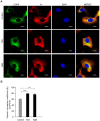HDAC-Specific Inhibitors Induce the Release of Porcine Epidemic Diarrhea Virus via the COPII-Coated Vesicles
- PMID: 37766280
- PMCID: PMC10534748
- DOI: 10.3390/v15091874
HDAC-Specific Inhibitors Induce the Release of Porcine Epidemic Diarrhea Virus via the COPII-Coated Vesicles
Abstract
Porcine epidemic diarrhea virus (PEDV) is an alpha-coronavirus causing acute diarrhea and high mortality in neonatal suckling piglets, resulting in huge economic losses for the global swine industry. The replication, assembly and cell egression of PEDV, an enveloped RNA virus, are mediated via altered intracellular trafficking. The underlying mechanisms of PEDV secretion are poorly understood. In this study, we found that the histone deacetylase (HDAC)-specific inhibitors, trichostatin A (TSA) and sodium butyrate (NaB), facilitate the secretion of infectious PEDV particles without interfering with its assembly. We found that PEDV N protein and its replicative intermediate dsRNA colocalize with coat protein complex II (COPII)-coated vesicles. We also showed that the colocalization of PEDV and COPII is enhanced by the HDAC-specific inhibitors. In addition, ultrastructural analysis revealed that the HDAC-specific inhibitors promote COPII-coated vesicles carrying PEDV virions and the secretion of COPII-coated vesicles. Consistently, HDAC-specific inhibitors-induced PEDV particle secretion was abolished by Sec24B knockdown, implying that the HDAC-specific inhibitors-mediated COPII-coated vesicles are required for PEDV secretion. Taken together, our findings provide initial evidence suggesting that PEDV virions can assemble in the endoplasmic reticulum (ER) and bud off from the ER in the COPII-coated vesicles. HDAC-specific inhibitors promote PEDV release by hijacking the COPII-coated vesicles.
Keywords: COPII-coated vesicles; HDAC-specific inhibitors; porcine epidemic diarrhea virus; viral release.
Conflict of interest statement
The authors declare no conflict of interest.
Figures







Similar articles
-
Hepatitis C Virus Lipoviroparticles Assemble in the Endoplasmic Reticulum (ER) and Bud off from the ER to the Golgi Compartment in COPII Vesicles.J Virol. 2017 Jul 12;91(15):e00499-17. doi: 10.1128/JVI.00499-17. Print 2017 Aug 1. J Virol. 2017. PMID: 28515296 Free PMC article.
-
Porcine Epidemic Diarrhea Virus Infection Induces Caspase-8-Mediated G3BP1 Cleavage and Subverts Stress Granules To Promote Viral Replication.J Virol. 2021 Apr 12;95(9):e02344-20. doi: 10.1128/JVI.02344-20. Print 2021 Apr 12. J Virol. 2021. PMID: 33568512 Free PMC article.
-
miRNAs derived from milk small extracellular vesicles inhibit porcine epidemic diarrhea virus infection.Antiviral Res. 2023 Apr;212:105579. doi: 10.1016/j.antiviral.2023.105579. Epub 2023 Mar 11. Antiviral Res. 2023. PMID: 36907442
-
Porcine epidemic diarrhea virus: Molecular mechanisms of attenuation and vaccines.Microb Pathog. 2020 Dec;149:104553. doi: 10.1016/j.micpath.2020.104553. Epub 2020 Oct 1. Microb Pathog. 2020. PMID: 33011361 Free PMC article. Review.
-
A Comprehensive View on the Host Factors and Viral Proteins Associated With Porcine Epidemic Diarrhea Virus Infection.Front Microbiol. 2021 Dec 7;12:762358. doi: 10.3389/fmicb.2021.762358. eCollection 2021. Front Microbiol. 2021. PMID: 34950116 Free PMC article. Review.
Cited by
-
Acetylation in Viral Infection and Disease.Results Probl Cell Differ. 2025;75:329-361. doi: 10.1007/978-3-031-91459-1_12. Results Probl Cell Differ. 2025. PMID: 40593216 Review.
References
Grants and funding
LinkOut - more resources
Full Text Sources
Research Materials

